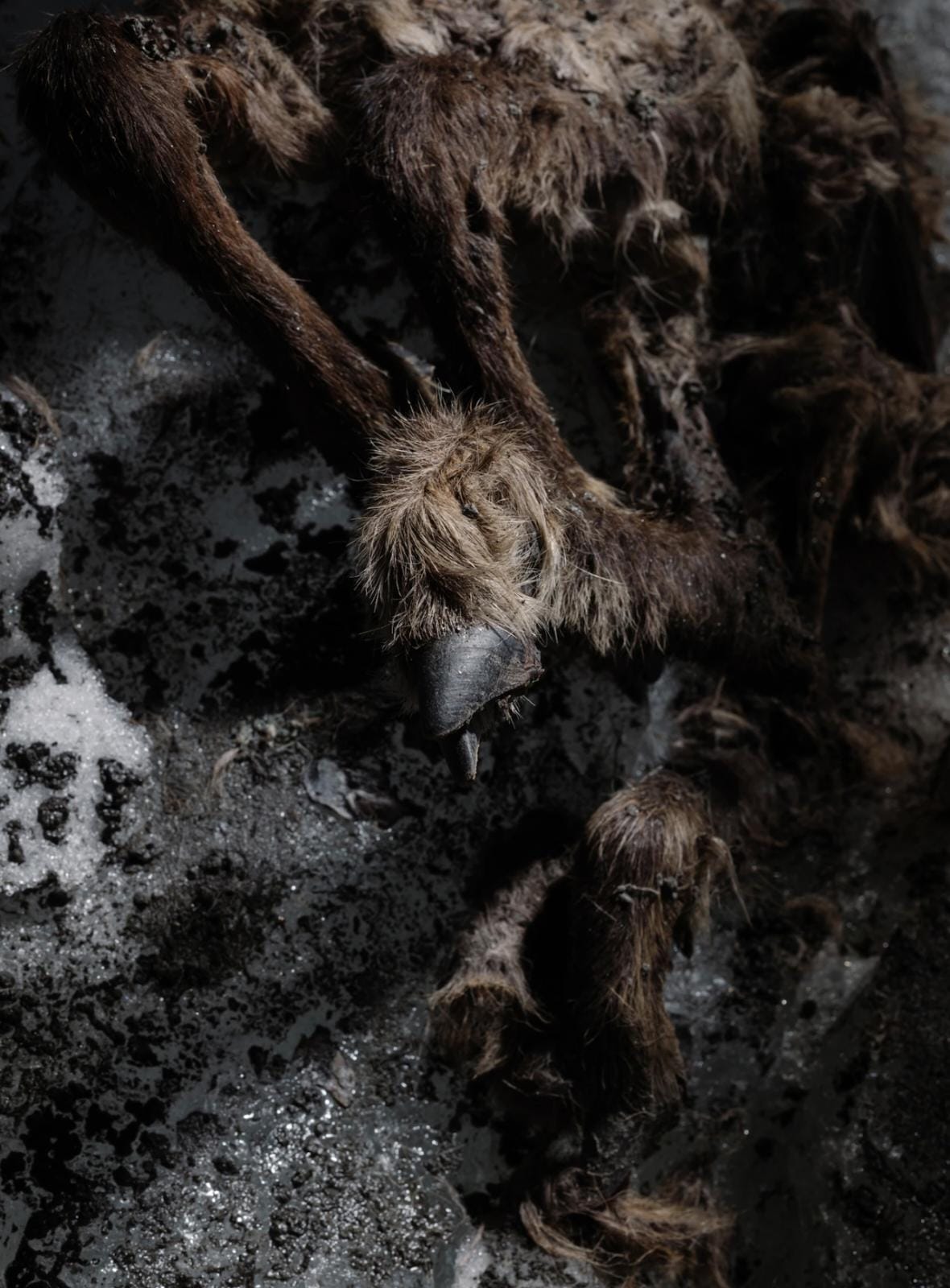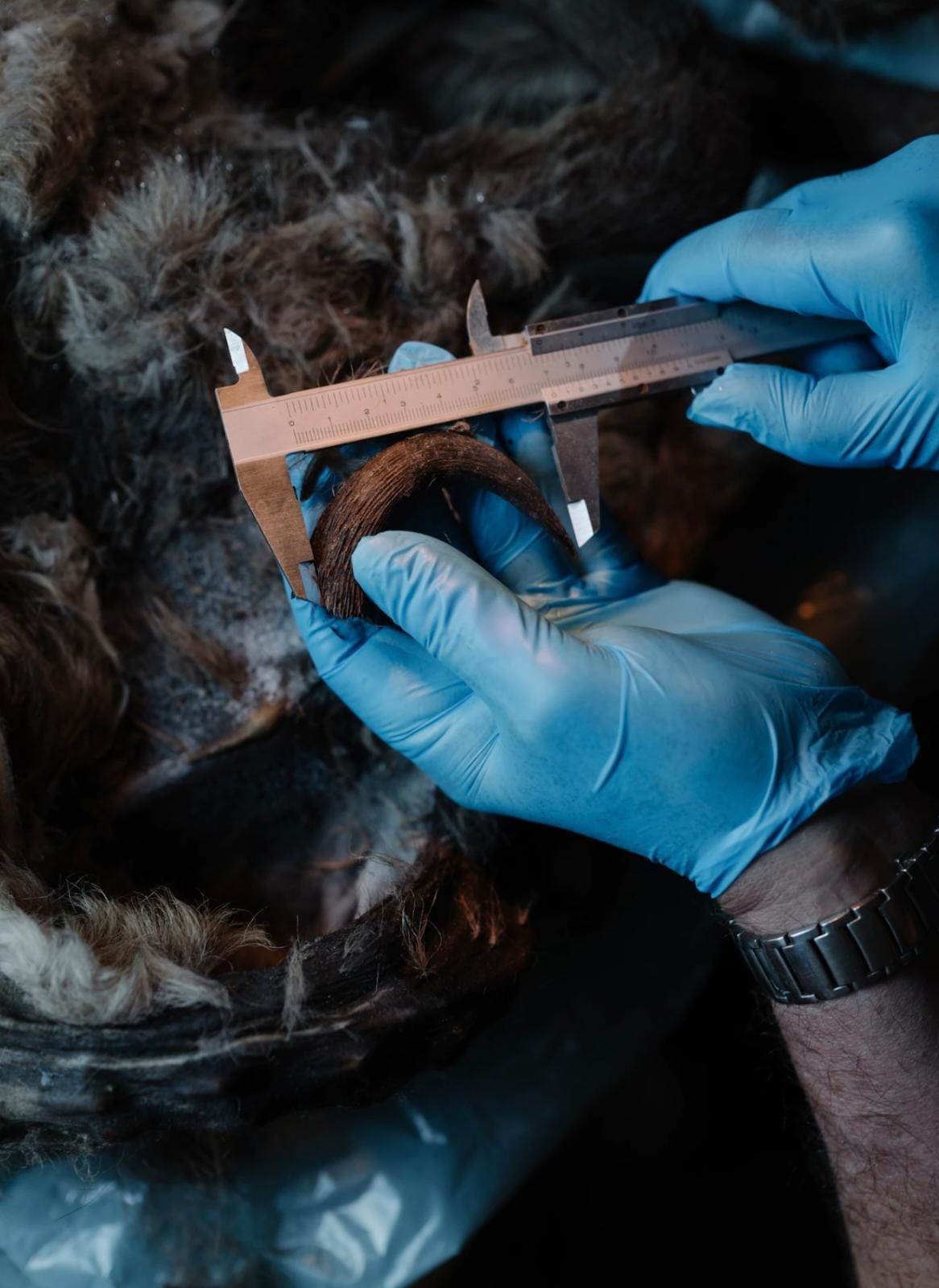 By: Kazim Raza Bhatti Pride News Italy 🇮🇹: GEPATSCHFERNER, AUSTRIA Her feet steady on the glacier, Andrea Fischer pulls the blade of her chainsaw in a circle through the ice, shards flying toward her face. Inside the circle: a mummified chamois, an endearing goat-antelope mix perfectly adapted to the Alps. This one was just a kid—a young female no more than two feet tall.
By: Kazim Raza Bhatti Pride News Italy 🇮🇹: GEPATSCHFERNER, AUSTRIA Her feet steady on the glacier, Andrea Fischer pulls the blade of her chainsaw in a circle through the ice, shards flying toward her face. Inside the circle: a mummified chamois, an endearing goat-antelope mix perfectly adapted to the Alps. This one was just a kid—a young female no more than two feet tall.
“We believe that she is about 500 years old,” says Fischer, an Alpine glaciologist from the Institute for Interdisciplinary Mountain Research in Innsbruck.
The skin has slid off the animal’s head, pulling one horn with it and laying bare her deep eye sockets, but it’s still stretched taut and leathery over vertebrae and her ribcage. Tufts of walnut-colored fur, rippling in the wind, cover her hooved legs—powerful, agile limbs that in life would have launched her from rock to rock. In her last moments, she drew them close. She was probably around two years old. “It’s incredible, and it’s incredible that she’s sitting exactly where we do our research, and that we passed right when it was coming out of the ice,” says Fischer, who has been studying Austria’s dwindling glaciers for more than two decades. A colleague named Martin Stocker-Waldhuber was checking on a weather station when he saw the chamois’ horns peeking out of melting ice, more than 11,000 feet up on Gepatschferner, a large glacier on the Italian border.National Geographic Logo – HomeSKIP
a decayed corpse of a goat like animal sits exposed as glacier ice melts around it
ENVIRONMENT
500-year-old ‘goatelope’ mummy found in melting European glacier
The small chamois, a kind of goat-antelope, may herald more spectacular finds to come this summer—another Ötzi the Iceman?—as glaciers in the Alps melt at a record-breaking pace.
The mummified chamois, a young female, lies exposed on the Gepatschferner, Austria’s second largest glacier, near the Italian border and the summit of the Weißseespitze. The chamois is estimated to be about 500 years old.
GEPATSCHFERNER, AUSTRIAHer feet steady on the glacier, Andrea Fischer pulls the blade of her chainsaw in a circle through the ice, shards flying toward her face. Inside the circle: a mummified chamois, an endearing goat-antelope mix perfectly adapted to the Alps. This one was just a kid—a young female no more than two feet tall.
“We believe that she is about 500 years old,” says Fischer, an Alpine glaciologist from the Institute for Interdisciplinary Mountain Research in Innsbruck.
The skin has slid off the animal’s head, pulling one horn with it and laying bare her deep eye sockets, but it’s still stretched taut and leathery over vertebrae and her ribcage. Tufts of walnut-colored fur, rippling in the wind, cover her hooved legs—powerful, agile limbs that in life would have launched her from rock to rock. In her last moments, she drew them close. She was probably around two years old.
a woman in a red puffy coat picks up the frozen and decaying remains of a goat like creature frozen in a glacier
Glaciologist and team leader Andrea Fischer places the chamois on a plastic tarp for transportation.
Details of the frozen chamois
the black hoof of a frozen goat like animal
Top: A close-up shows the chamois’ neck. Fischer collected the bits of fur scattered on the ice.
Bottom: Fur still clung to the animal’s powerful legs, which in life allowed it to leap from rock to rock in the high Alps.
“It’s incredible, and it’s incredible that she’s sitting exactly where we do our research, and that we passed right when it was coming out of the ice,” says Fischer, who has been studying Austria’s dwindling glaciers for more than two decades. A colleague named Martin Stocker-Waldhuber was checking on a weather station when he saw the chamois’ horns peeking out of melting ice, more than 11,000 feet up on Gepatschferner, a large glacier on the Italian border.
Glaciers all over the Alps are melting at an unprecedented rate this summer. Last winter’s scant snows melted early, leaving the ice unprotected against the heat waves that have lately swept across the continent. By the end of the season, Fischer says, as much as seven meters of ice, or 23 feet, will have melted off the surface of glaciers in the eastern Alps—far more than in any previous year.
Sad as this dramatic loss is, there’s also a thrilling sense of anticipation: What other well-preserved relics of the past might emerge from the ice?
In recent years, long-lost hikers have been found in the Alps, as well as frozen soldiers from the high-altitude battle that Italy and Austria waged against each other during World War I. About 150,000 men died, and many were buried by avalanches or froze to death in snowstorms. Some have been found partially mummified in the ice.
“With the melting of the glaciers, there should be more of these finds, maybe also other humans showing up in the ice,” says Albert Zink, head of the institute for mummy studies at Eurac Research, in Bolzano, Italy. “Actually, it’s quite likely.”National Geographic Logo
A decayed corpse of a goat like animal sits exposed as glacier ice melts around it
ENVIRONMENT
Her feet steady on the glacier, Andrea Fischer pulls the blade of her chainsaw in a circle through the ice, shards flying toward her face. Inside the circle: a mummified chamois, an endearing goat-antelope mix perfectly adapted to the Alps. This one was just a kid—a young female no more than two feet tall.
“We believe that she is about 500 years old,” says Fischer, an Alpine glaciologist from the Institute for Interdisciplinary Mountain Research in Innsbruck.
The skin has slid off the animal’s head, pulling one horn with it and laying bare her deep eye sockets, but it’s still stretched taut and leathery over vertebrae and her ribcage. Tufts of walnut-colored fur, rippling in the wind, cover her hooved legs—powerful, agile limbs that in life would have launched her from rock to rock. In her last moments, she drew them close. She was probably around two years old. “It’s incredible, and it’s incredible that she’s sitting exactly where we do our research, and that we passed right when it was coming out of the ice,” says Fischer, who has been studying Austria’s dwindling glaciers for more than two decades. A colleague named Martin Stocker-Waldhuber was checking on a weather station when he saw the chamois’ horns peeking out of melting ice, more than 11,000 feet up on Gepatschferner, a large glacier on the Italian border.
A woman in a red puffy coat picks up the frozen and decaying remains of a goat like creature frozen in a glacier
Glaciologist and team leader Andrea Fischer places the chamois on a plastic tarp for transportation.
Details of the frozen chamois
the black hoof of a frozen goat like animal
Top: A close-up shows the chamois’ neck. Fischer collected the bits of fur scattered on the ice.
Bottom: Fur still clung to the animal’s powerful legs, which in life allowed it to leap from rock to rock in the high Alps.
“It’s incredible, and it’s incredible that she’s sitting exactly where we do our research, and that we passed right when it was coming out of the ice,” says Fischer, who has been studying Austria’s dwindling glaciers for more than two decades. A colleague named Martin Stocker-Waldhuber was checking on a weather station when he saw the chamois’ horns peeking out of melting ice, more than 11,000 feet up on Gepatschferner, a large glacier on the Italian border.
Glaciers all over the Alps are melting at an unprecedented rate this summer. Last winter’s scant snows melted early, leaving the ice unprotected against the heat waves that have lately swept across the continent. By the end of the season, Fischer says, as much as seven meters of ice, or 23 feet, will have melted off the surface of glaciers in the eastern Alps—far more than in any previous year.
Sad as this dramatic loss is, there’s also a thrilling sense of anticipation: What other well-preserved relics of the past might emerge from the ice?
In recent years, long-lost hikers have been found in the Alps, as well as frozen soldiers from the high-altitude battle that Italy and Austria waged against each other during World War I. About 150,000 men died, and many were buried by avalanches or froze to death in snowstorms. Some have been found partially mummified in the ice.
“With the melting of the glaciers, there should be more of these finds, maybe also other humans showing up in the ice,” says Albert Zink, head of the institute for mummy studies at Eurac Research, in Bolzano, Italy. “Actually, it’s quite likely.”
The chamois mummy was found a short distance from the researchers’ weather station, on a relatively flat part of the glacier.
What everyone’s hoping for, he says, is another prehistoric human like the one he has been studying for more than a decade: Ötzi the Iceman, discovered by pure chance in 1991. Ötzi is five thousand years old, ten times older than Fischer’s chamois—but thousands of years’ worth of ice are melting in the Alps this summer.
The chamois may just be the beginning.
A chopper to the chamois
Early on August 4, photographer Ciril Jazbec and I joined Fischer and her team for the helicopter flight to the top of Gepatschferner, where the clouds sit at eye level.
Stocker-Waldhuber actually first saw the horns sticking out of the ice last summer, but too little of the animal was emerging for it to be extracted safely before winter snow buried it again. After much more melt this summer, the researchers seized a narrow window of opportunity to retrieve the chamois. At 11,500 feet, the weather can change in an instant, rendering helicopter flights too dangerous. And once fully exposed to the air by the melting ice, the mummy will quickly decompose—if bearded vultures circling in the sky above the glacier don’t devour it first.
 Pride News Daily NEWS
Pride News Daily NEWS





